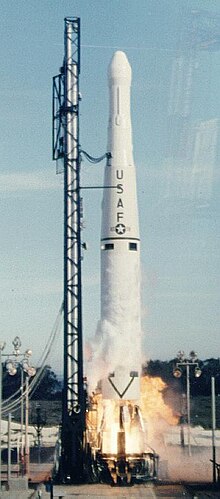
Back Thor Ablestar Galician תור-אייבלסטאר HE Thor-Ablestar ID Thor Able Star Polish Thor-Ablestar Portuguese Тор-Эйблстар Russian
 The launch of a Thor-Ablestar 2 with a Transit satellite. | |
| Function | Orbital carrier rocket |
|---|---|
| Manufacturer | Douglas / Aerojet |
| Country of origin | United States |
| Size | |
| Height | 29 metres (95 ft) |
| Diameter | 2.44 metres (8 ft 0 in) |
| Mass | 53,000 kilograms (117,000 lb) |
| Stages | 2 |
| Capacity | |
| Payload to 1100km LEO | |
| Mass | 150 kilograms (330 lb) |
| Associated rockets | |
| Family | Thor |
| Comparable | Delta |
| Launch history | |
| Launch sites | LC-17, Canaveral LC-75-1, Arguello |
| Total launches | 19 |
| Success(es) | 12 |
| Failure(s) | 5 |
| Partial failure(s) | 2 |
| First flight | 13 April 1960 |
| Last flight | 13 August 1965 |
| First stage – Thor | |
| Powered by | 1 MB-3-1 |
| Maximum thrust | 760.64 kilonewtons (171,000 lbf) |
| Specific impulse | 285 sec |
| Burn time | 164 seconds |
| Propellant | RP-1/LOX |
| Second stage – Ablestar | |
| Powered by | 1 AJ-10 |
| Maximum thrust | 36.02 kilonewtons (8,100 lbf) |
| Specific impulse | 280 sec |
| Burn time | 296 seconds |
| Propellant | HNO3/UDMH |
The Thor-Ablestar, or Thor-Able-Star, also known as Thor-Epsilon [1] was an early American expendable launch system consisting of a PGM-17 Thor missile, with an Ablestar upper stage. It was a member of the Thor family of rockets, and was derived from the Thor-Able.
The Ablestar second stage was an enlarged version of the Able, which gave the Thor-Ablestar a greater payload capacity compared to the Thor-Able. It also incorporated restart capabilities, allowing a multiple-burn trajectory to be flown, further increasing payload, or allowing the rocket to reach different orbits. It was the first rocket to be developed with such a capability and development of the stage took a mere eight months.[2]
Two versions were built; the Thor-Ablestar 1, with a DM-21 Thor and an AJ-10-104 second stage engine, and the Thor-Ablestar 2, which had a DSV-2A Thor first stage, and an uprated AJ-10-104D engine on the second stage.[1] Thor-Ablestar 1 launches occurred from LC-17 at Cape Canaveral, and Thor-Ablestar 2 rockets were launched from LC-75-1 at Vandenberg Space Force Base (now designated SLC-2).
- ^ a b Krebs, Gunter. "Thor Able-Star". Gunter's Space Page. Retrieved 30 November 2008.
- ^ Wade, Mark. "Delta". Encyclopedia Astronautica. Archived from the original on 17 August 2013. Retrieved 30 November 2008.